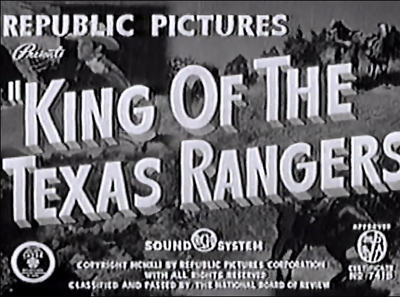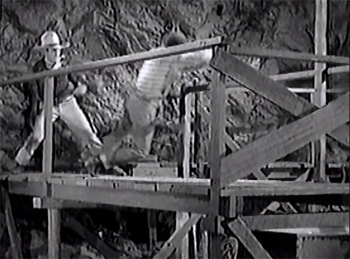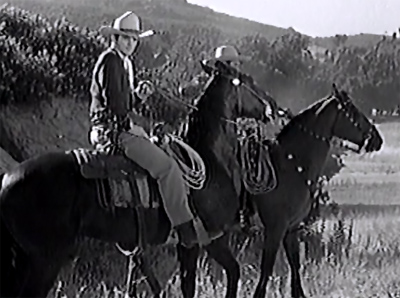
Republic, 12 Chapters, 1941. Starring “Slingin'” Sammy Baugh, Duncan Renaldo, Pauline Moore, Neil Hamilton, Charles Trowbridge, Kermit Maynard, Stanley Blystone, Roy Barcroft, Rudolph Anders.
Texas Ranger captain Tom King (Monte Blue) is murdered just as he’s on the verge of smashing a sabotage ring that’s been operating in Texas and Mexico–but his son, college football star Tom King Jr. (Sammy Baugh), picks up where his father left off, taking on the slain Ranger’s badge and his important assignment. With the help of Mexican Rurales officer Pedro Garcia (Duncan Renaldo) and small-town newspaper editress Sally Crane (Pauline Moore), the new Ranger quickly begins to hamper the sabotage ring’s operations; King and his allies are unaware, however, that upright rancher and oil-company stockholder John Barton (Neil Hamilton) is the leader of the saboteurs–or that Barton’s backer, a high-ranking foreign military officer (Rudolph Anders), is overseeing the sabotage activities from a lurking zeppelin high above Texas.
King of the Texas Rangers combines two serial sub-genres (the counter-espionage thriller and the Western) to excellent effect; the genre mixing allows for a variegated assortment of plot threads, action scenes, and locations that could never have been duplicated in either a conventional spy-fighting serial or a standard cowboy chapterplay. The result is one of the most colorful and entertaining of all of Republic’s Golden Age serials.
Writers Norman Hall, Joseph O’Donnell, Ronald Davidson, Joseph Poland, and William Lively pace Texas Rangers’ screenplay exceptionally well, deftly balancing three interrelated subplots–a struggle over a valuable airplane-fuel formula, the villains’ sabotage campaign against the Dobe Hills oil field (where the fuel is slated to be produced), and King’s pursuit of the saboteur group’s key operatives. Assaults on the Dobe Hills oil supply, its derricks, or its power source are alternated with attempts to kidnap or kill the formula’s inventor, and with protracted Ranger trackdowns of important suspects–ensuring that none of the subplots wears out its welcome; the writers also set the narrative moving towards its conclusion remarkably early, with King striking a trail of evidence in Chapter Six that eventually leads to the unmasking of Barton. By building up to the climax in this sequential fashion, and by refusing to over-emphasize either the oil-field sabotage or the battle for the formula, the writers prevent Rangers’ storyline from ever seeming padded or repetitious–no small accomplishment, considering that the serial lacks the type of single unifying MacGuffin (a lost treasure, a powerful scientific gadget, etc.) used to keep the narratives of other Golden Age serials on a forward-moving track.
Texas Rangers’ action scenes are similarly non-repetitive; the serial’s Western milieu gives rise to innumerable outdoor shootouts and chases, while the contemporary setting permits such scenes to utilize cars, trucks, trains, motorboats, and airplanes as well as the expected horses and wagons. These widely varied (and extremely well-staged) action sequences are set against an equally varied assortment of backdrops; directors William Witney and John English make use not only of familiar movie-making locations like Iverson’s Ranch, Corriganville, and the Lake Sherwood area, but also of a functioning oil field and other “genuine” locations like a dockyard and a towering canyon dam. Fistfights are scarcer here than in most other 1940s Republic’s outings, which makes the serial’s big fight setpieces stand out more than usual when they do come–and also adds to the pleasantly unpredictable feel of the serial’s action; a viewer of Texas Rangers can never be sure whether a hero-villain confrontation will lead to a slam-bang brawl, an exchange of gunfire, or a furious chase.




Above, top left: A Ranger car races after the villains along an oil-field road. Top right: The hero springs from a dock to surprise a henchman. Bottom left: The hero crosses a chasm at Corriganville. Bottom right: A henchman atop the above-mentioned dam.
A few of the action highlights include the hero’s short but dramatic cantina gunfight with his father’s killers in Chapter One, the Chapter Three seaside sequence (which includes an eye-catching leap from a dock and a transfer from one speeding motorboat to another), the fights outside and inside the mine in Chapter Four, the multiple fistfights, gunfights, and chases arising from the back-tracking of the oil line in Chapters Six and Seven, the escape from the Mexican fort in Chapter Nine (which begins with a shootout, segues into a horse/wagon chase, and ends with a leap into Lake Sherwood), Chapter Eleven’s dynamic fistfight and ensuing horseback chase, and the rousing aerial battle with the zeppelin in the final episode. Tom Steele doubles star Sammy Baugh in the fight scenes, with Dave Sharpe taking over for the more acrobatic stunts–like the spectacular wire-slide from the top of an oil derrick in Chapter Six. Sharpe also stands in for sidekick Duncan Renaldo in that Chapter Eleven fistfight, with Ken Terrell doubling for his villainous opponent. Both Terrell and Sharpe double several other heavies throughout the serial–as do (among others) Jimmy Fawcett, Duke Green, Duke Taylor, Joe Yrigoyen, and Bud Wolfe.




Above, top left: Dave Sharpe (doubling Sammy Baugh) prepares to leap into the villains’ motorboat. Top right: Sharpe (now doubling Kenne Duncan) is knocked flying by Tom Steele (doubling Baugh). Bottom left: Baugh (doing his own riding here as elsewhere) tries to yank henchman Al Taylor from his horse. Bottom right: The heroes’ biplane buzzes the villains’ dirigible (miniatures provided by the Lydecker Brothers).
The hero’s Chapter One race through a ferocious oil-field fire in search of the captive heroine is another of the serial’s action highlights; the Lydecker Brothers’ stunning miniature work here ranks as some of their very best. This sequence leads to the first of several excellent chapter endings (a blazing oil derrick toppling onto the protagonists); other standout cliffhangers include the runaway mining-car scene in Chapter Four, the hero’s Chapter Six fall from his horse into a chasm, and the Chapter Seven ending that has a heavy barreling a truck into a cabin containing the hero. The Chapter Two train-tunnel explosion and the exploding truck’s plummet from a dam at the end of Chapter Eleven are also first-rate; both were borrowed from Republic feature films (The Great Train Robbery and Born to be Wild, respectively) but work beautifully here, being edited into the serial in Republic’s customarily smooth style.


Above: Shots from the oil-field fire that concludes Chapter One.
Some critics have flagged Texas Rangers’ leading man–football legend “Slingin'” Sammy Baugh–as a detriment to the serial, but I can’t agree with this line of criticism myself; Baugh was no professional actor, but he makes a satisfactory protagonist nonetheless. His facial expressions are not exactly flexible, but the grave and intent look he wears throughout most of the serial fits well with the terse and serious dialogue he’s given; his line delivery, though sometimes awkward and occasionally difficult to understand (due to his deep voice and thick Texas accent), is marked by likable earnestness and sincerity. He also brings an authenticity to his role that few professionals could have matched; his accent, lankily athletic frame, cowboy’s squint, and top-notch riding skills all combine to make him look and sound like a bona fide Texas Ranger, not an actor pretending to be one. Overall, Baugh’s performance, unpolished as it is, comes off as so unaffected and so “real” that it’s quite appealing in its own low-key way.
Duncan Renaldo makes an ideal assistant for Baugh, his effervescence counterbalancing the football star’s stoicism throughout the serial. Though he’s unfailingly exuberant, he never makes his character seem comical; he participates in most of the action scenes in dashingly capable fashion and serves as more of a co-hero than a sidekick. Leading lady Pauline Moore brings a lovely speaking voice, a perkily attractive “girl next door” appearance, and an exceedingly pleasant screen personality to her role; her ability to convey both fervent concern and sparkling cheerfulness (without overdoing either) makes her characterization very endearing.

Above: Duncan Renaldo and Pauline Moore spot the villains up to no good.
The distinguished Neil Hamilton–in his only serial role–does a terrific job as the serial’s brains heavy, playing the part with the same gusto he brought to all his feature-film and television performances. His dignified but affably jaunty manner when he’s posing as a solid citizen is quite likable, and makes the heroes’ trust in him entirely convincing; he handles the villainous side of his two-faced character with the same aplomb–curtly and confidently issuing orders to his henchmen, making reports to his own commander with grim assurance, grinning in smugly evil fashion when things seem to be going well for him, and confronting the good guys in angrily aggressive fashion when he’s finally unmasked.

Above: Stanley Blystone (left) receives orders from Neil Hamilton.
As Hamilton’s zeppelin-commanding superior, German-born actor Rudolph Anders (billed here under the more American name of Robert O. Davis) does little but issue occasional instructions to his earthbound representative; however, he does so in properly sinister and coldly militaristic style, giving his character a recognizably Nazi-like manner without the writers ever having to explicitly state his nationality. Stanley Blystone is more cunning and less thuggish than usual–though still intimidatingly gruff–as Lynch, the crooked lawyer who periodically plots with Hamilton’s Barton and relays the latter’s orders to the henchman pack.

Above: Rudolph Anders as “His Excellency” (the only name his character is ever given).
Said pack is one of the best ever assembled for a single serial: its most notable members include crafty Kenne Duncan, slimy Robert Barron, sarcastic Jack Ingram, and swaggering Bud Geary, with the tough and sly Roy Barcroft serving as the group’s leader. These excellent heavies effectively carry the villains’ side of the action by themselves for chapters at a time, each henchman getting at least one or two moments in the spotlight. The snub-nosed and rough-voiced Alan Gregg is effective as another prominent pack member, while the menacingly nasty Frank Bruno has a small but memorable turn as the slayer of the hero’s father. Monte Montague is Bruno’s accomplice, and Al Taylor plays an important part in the eleventh chapter as Neil Hamilton’s ranch foreman.


Above, left to right across both pictures: Kenne Duncan, Jack Ingram, Roy Barcroft, Robert Barron, and Bud Geary.
The serial’s roster of supporting good guys is impressive as well. As Crawford, the chairman of the Dobe Hills oil company, gray-haired Charles Trowbridge exudes statesmanlike dignity, using his mellifluous voice to good effect as he outlines the heroes’ courses of action. Drawling former cowboy star Kermit Maynard provides Baugh and Renaldo with genial backup throughout as Texas Ranger Wichita Bates, although he is given no opportunity to show off his superlative riding skills. Herbert Rawlinson is very good in his solemn but kindly bits as a Ranger colonel in the first and last chapters, Frank Darien is colorfully cheerful as the heroine’s grizzled newspaper printer, and Joseph Forte is both professorially mild-mannered and quietly courageous as Nelson, the beleaguered inventor of the airplane-fuel formula. Monte Blue, in his all-too-brief turn as the hero’s father, is likably tough and determined.


Above left: Charles Trowbridge. Above right: Kermit Maynard.
Henry Hall is a dignified and resourceful doctor, Hooper Atchley a pharmacist, Forrest Taylor a jovial records-office clerk, Jack Chapin the hero’s football teammate, Edward Cassidy an oil-well foreman, Iron Eyes Cody a Rurale, vaudeville comic Bobby Barber a Mexican vegetable peddler, Eddie Dew a dam guard, and Michael Owen the son of the inventor Nelson. John Bagni, Slim Whitaker, Charles Thomas, and Ernest Sarracino have small thug roles, while Buddy Roosevelt and Richard Simmons (television’s future Sergeant Preston) pop up as Rangers. Some, but not all, of the stuntmen appear in henchman bits, with Jimmy Fawcett the most memorable as a smirking outlaw who threatens a fuel-truck driver with a live hand grenade; John James is also very good as the aforesaid driver, conveying both panic and resolute heroism. Nasty-looking Lucien Prival is given prominent billing–but almost no dialogue–as Rudolph Anders’ aide-de-camp.
Cy Feuer’s terrific musical score for Texas Rangers is centered around a rousing fife-and-drum-based arrangement of “Will You Come to the Bower”–the fight song of Baugh’s real-life college football team (the Texas Christian University Horned Frogs), and an unofficial Texas state anthem as well (being the tune played by Sam Houston’s men at the battle of San Jacinto). The piece serves as appropriate underscoring for several dramatic moments and many action scenes, and also gets each chapter off to a stirring start–beginning as a measured march as the serial’s title card appears, and slowly gathering speed as the credits continue to roll.
King of the Texas Rangers‘ strong plotting, pacing, and production values, its highly heterogeneous collection of action scenes, and its large and stellar cast make it tremendously enjoyable and almost addictively re-watchable. It’s my own favorite Republic serial, and while perhaps few other reviewers would assign it to such a preeminent spot, it has received deservedly high marks from almost all other fans of the genre.
Addendum: For more background information on King of the Texas Rangers, and for some pleasant recollections from its star, click HERE to read the Old Corral’s copy of a 1974 Les Adams interview with Sammy Baugh.



I have always thought that Baugh was just fine as the hero. Like you said, he comes across as authentic, could really pass for a Texas Ranger. Director William Witney said Baugh could ride a horse with the best of them. Some detractors claim Baugh pronounces Duncan Renaldo’s character, Pedro as “Peedro,” he doesn’t, it’s Kermit Maynard that does that. I wonder why the crew didn’t correct him?
I didn’t like the last chapter gimmick of suddenly coming up with an exact double for Barton. It is a serial cliche that you can always find an exact match for everyone. Look how many serials that was done in, plus a few others where a mask is worn to accomplish that.
While not my favorite, King ranks a close second!From the opening credits to the closing chapter, I found it to be completely satisfying . Though Baugh was not an actor I found a freshness in the way he handled his role. The score has stayed with me over the years and the action scenes are the best in any serial. This is another one in my tape collection. I rank this ***** stars out of *****.
I got this serial back in the 90’s on VHS and I only watched the first couple of chapters. At the time I really couldn’t take Baugh’s acting and the plot seemed rather boring. I recently watched it all the way through and have to agree that it is a great serial. The pacing was fast but not frantic, continuity satisfying, the feel was wide open, lots of different kinds of action in so many settings, land, sea, and air, great outdoor locations (the dam was outstanding), stunting and miniature work were both excellent (minus the visible wires on the dirigible), rousing opening theme, only a couple of cheats, and giving Baugh the benefit of the doubt this time the acting was all first rate. It seemed like a good faith effort to entertain with a good yarn, I just felt kind of at home watching it. I’ll watch it again before too long.
Excellent review. Don’t know if I would rate it the very best from Republic, but it is close to the top. I like Baugh okay. As you said, the best and most varied action scenes. And Neil Hamilton was a great villain. ***** out of *****
This and Daredevils of theRed Circle are my absolute favorite serials,
Stanley Blystone is a regular performer for the Three Stooges and for modern viewers. So does Christine McIntyre.
“Zorror’s Fighting Legion” is the only western serial I would rank ahead of “King of he Texas Rangers” both of these serials are In the top five of my favorite Republic Serials, Captain Marvel, Spy Smasher and DareDevils of the Red Circle are also, in my top five.
“Rangers” is one of my all-time favorites, and one that I have watched over and over again, in no small part due to Sammy Baugh’s performance. He was not a trained actor, but he projected a reality that seemed totally in keeping with his character in the serial. He reminded me of many of the people I’ve known over the years living here in the Southwest.
Thanks also for the link to the Les Adams interview. It made for very interesting reading. I loved the comments about the hat they gave him to wear.